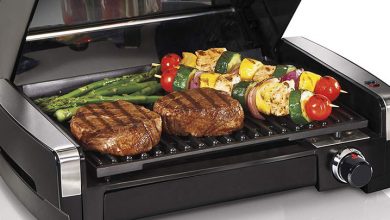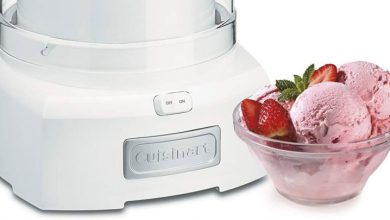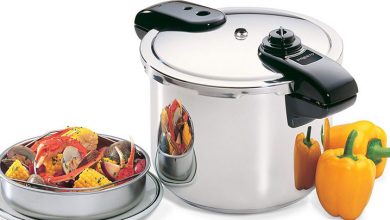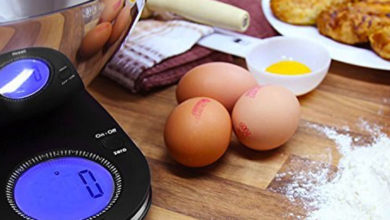
Without many words, we can immediately state that the pressure cooker is an excellent ally in the kitchen, offering undeniable advantages on both the taste and practical levels. It reduces the normal cooking time of foods by about one-third.
For those who lack time to prepare food or are dissatisfied with cooking in the microwave, the pressure cooker becomes an essential product that is difficult to give up. To understand if it’s really like that for you, let’s examine some key features of this long-established product, which remains mysterious to many.
Pressure Cooker: How it is made
At first glance, the pressure cooker resembles a large pot with a slightly different lid. But let’s go step by step. Unlike everyday cookware, pressure cookers are designed and produced with a thicker layer of steel and/or aluminum. The latest generation pans are crafted with a triple layer of steel-aluminum-steel, making them more resistant and, above all, ensuring they maintain high temperatures with minimal heat loss.
Usually, the pressure cooker is equipped with two large side handles lined with a non-stick material that quickly disperses heat, thereby avoiding burns if handled without potholders.
As we mentioned earlier, the second peculiarity of the pressure cooker is all enclosed within the lid: it is equipped with two crosspieces that hook to the top of the pot and a handle that hermetically seals the pot, preventing the leakage of vapor.
To prevent the pot from exploding, the lid must also be equipped with one or more steam vent valves. The latest generation pans are fitted with a special valve that minimizes the vertical dispersion of steam, resulting in a consequent reduction in liquid loss. At the top edge of the pot, a gasket allows for a total closure and a hermetic seal of the pot itself.
How a Pressure Cooker Works
The pressure cooker has been named this way because it exploits the increase in pressure that is created inside the pot itself. We explain better. Unlike everyday cookware, the hermetic seal prevents steam from escaping, and as the heat inside the pot rises, so does the pressure within both the pot and the food. The increase in pressure increases the temperature, a fundamental thermodynamic principle.
Unlike everyday cookware, where water reaches the boiling point at 100°C, in a pressure cooker, the water will boil only at approximately 130°C. This allows the food to cook faster, as it is immersed in a much warmer and constant environment. At the same time, the dispersion of liquids is limited, another feature much appreciated in some preparations.
To use the pot, insert the desired food inside, close the lid tightly, and switch on the desired heat source: when the appropriate pressure for cooking is reached, the pot valve will whistle. That will be the time to lower the flame or the heat source used for cooking, so that the temperature and pressure inside the pot remain constant, allowing the food to cook thoroughly. Times depend on food and quantity.
Pros and Cons of the Pressure Cooker
The Pros
First of all, we dispense with the well-known concern about danger: many people do not use pressure cookers because they fear they can cause domestic disasters, such as explosions, fires, and other similar catastrophes. It is not so. The latest generation of pans is equipped with devices that ensure a high standard of safety. These include gaskets made from resistant materials, additional safety valves, heat-escape valves produced with high-quality materials, and covers resistant to high pressures created inside the pot.
The pressure cooker is ideal for cooking foods that require lengthy cooking times, such as vegetables, rice, and cereals. Thanks to the pressure exerted on the food, they will be ready in about half the time: for example, you will have rice prepared in just 6 minutes, unlike the 15 required for traditional cooking.
In addition, all the foods cooked in a pressure cooker retain almost all the vitamins and proteins they contained before cooking, as well as the thermolabile vitamins that are not destroyed due to the speed of cooking, making them even more digestible.
The pressure cooker is also suitable for more elaborate types of cooking, thanks to the supplied baskets. It is possible to cook steamed vegetables, preserving their flavors and aromas unaltered, and to cook with the help of a grill to prevent the meat from absorbing too much water.
Another advantage, in our opinion, is the preservation of aromas: reducing the escape of steam and liquids to a minimum, as well as ensuring that proteins and vitamins are not dispersed, and even flavors and aromas remain inside the pot. As a result, the foods will be tastier, and you can minimize the use of salt or other spices to flavor foods.
Another appreciated feature: thanks to the hermetic seal, the pressure cooker retains heat for a longer time than normal cookware, eliminating the need to reheat food before lunch or dinner.
When the pressure cooker is in operation, you do not need to check it: once the flame is lowered under the pot, it will cook the food without requiring you to check, turn, or mix it. The cooking inside the pot is homogeneous, and consequently, the foods will have much smoother cooking than in standard pots.
Now that we have listed the advantages, we try to summarize them in a small scheme, so that they are more visible and easily memorized:
- Food cooking time decreases.
- It reduces the expenditure of heat and energy for cooking.
- It preserves the vitamins and proteins contained in food.
- It preserves the natural flavors of foods. Keep food warm longer.
- There is no need to check it while cooking food.
- Homogeneous cooking of the food is achieved through hermetic sealing.
- Safe thanks to safety devices.
- The latest generation valve enables the minimization of liquid dispersion.
- High digestibility of foods and healthy cuisine.
- Different types of cooking.
- Recommended for foods that require a long cooking time.
- Easy to use and clean.
Are there any Cons?
Some disadvantages are there. Indeed, for the most discerning cooks and purists, the pressure cooker is not very suitable since it is not possible to open it during cooking to control the food. It is also not recommended for those who love the kitchen characterized by full-bodied sauces, such as roasts and particular meats: cooking with a pressure cooker is above all a steaming that does not brown and roast the food.
Another thing must also be noted regarding cooking times: they indeed decrease, but at the same time, they must be calculated to perfection, as 2 minutes too many can be equivalent to burning or overcooking the food.
Finally, the pressure cooker is, on average, more expensive than traditional saucepans for obvious reasons and requires periodic maintenance, especially regarding the valve, which must always be clean and functional.



